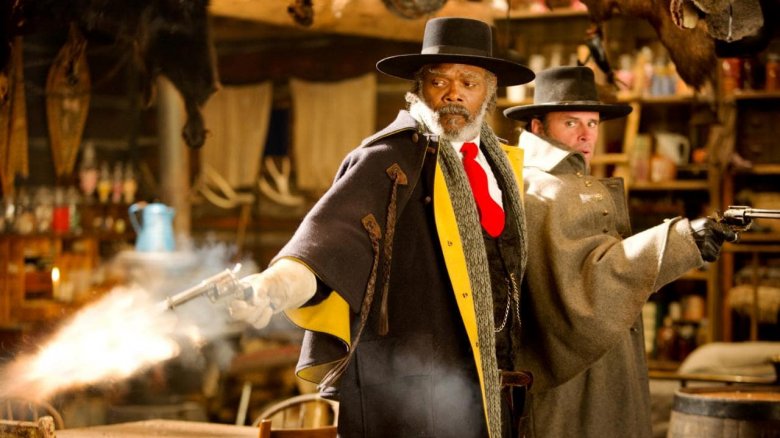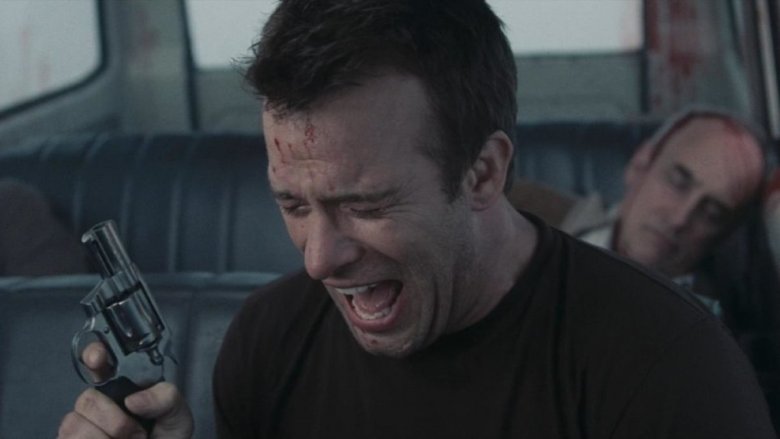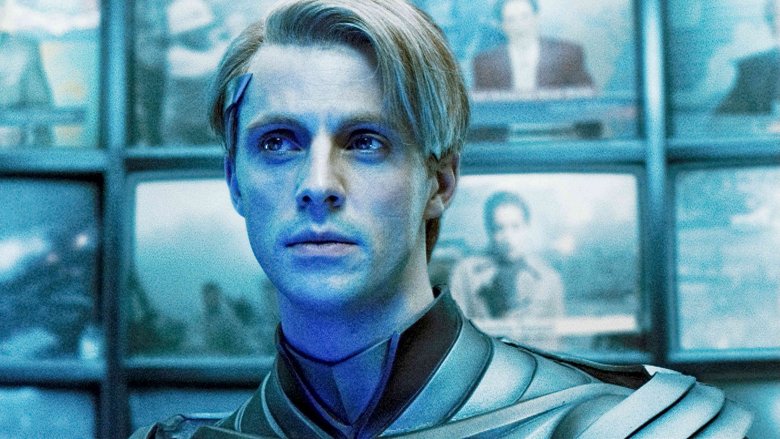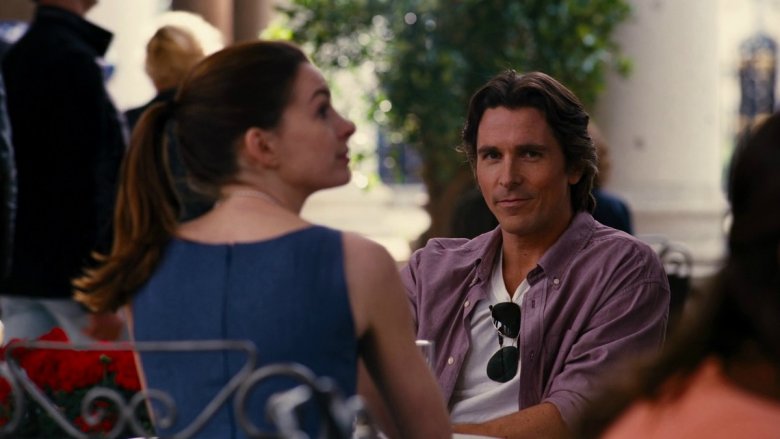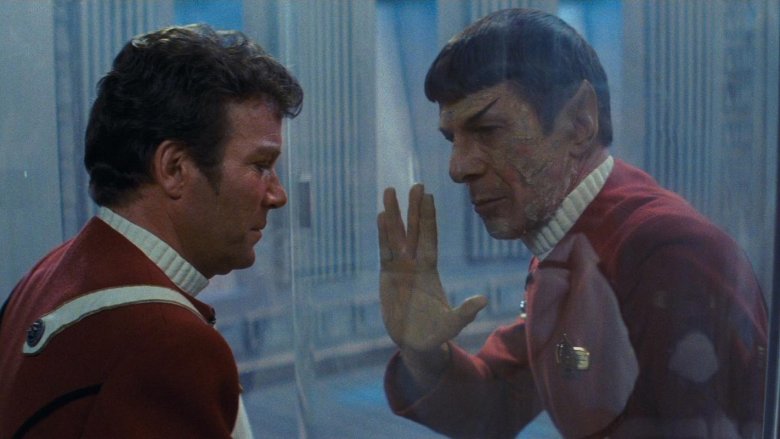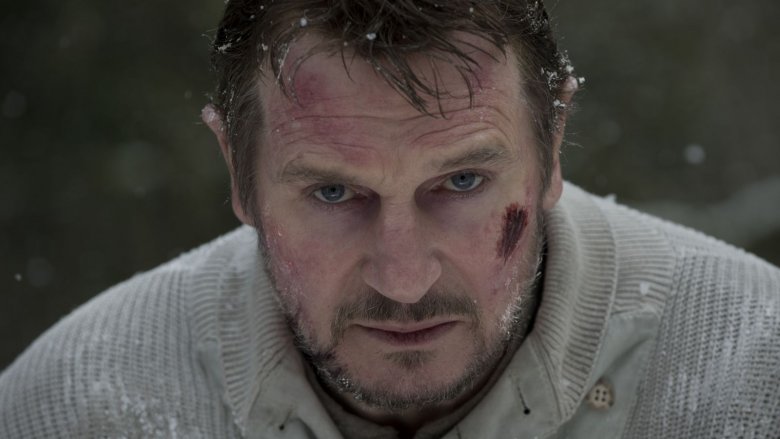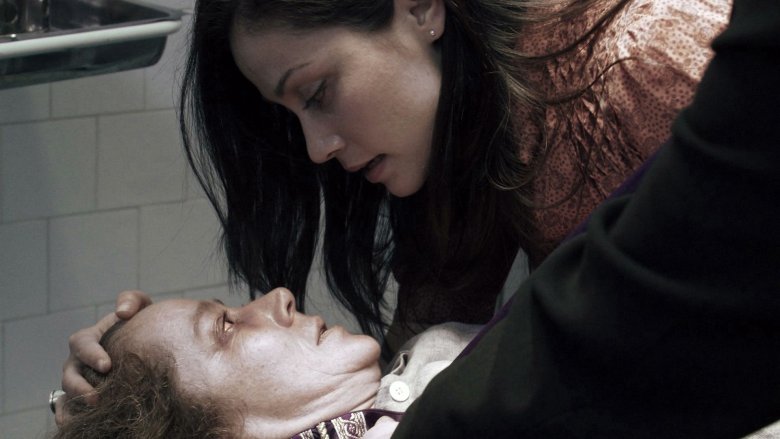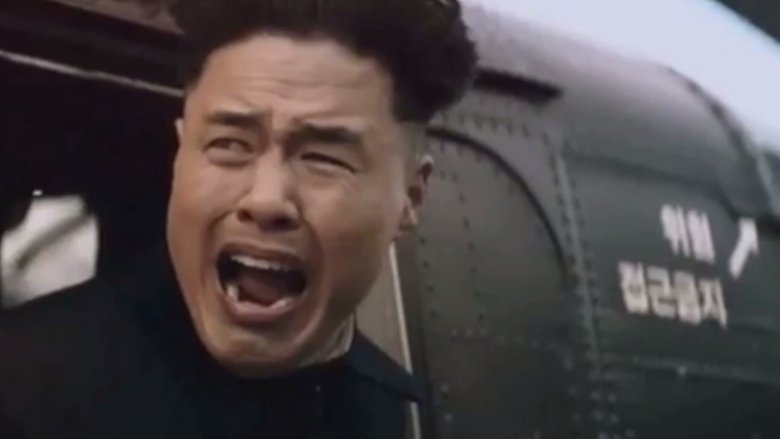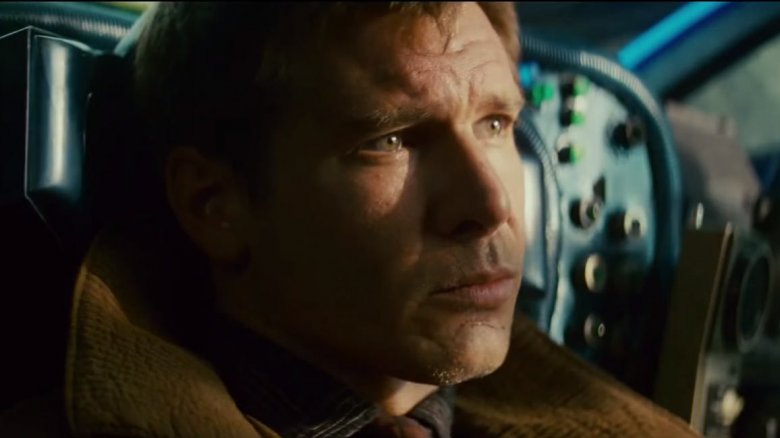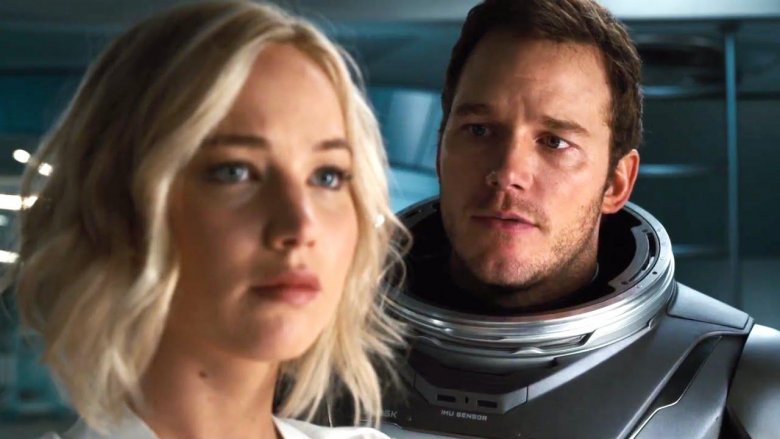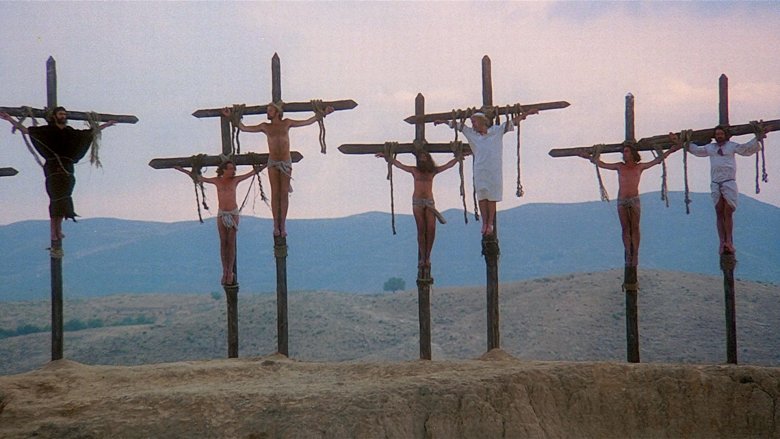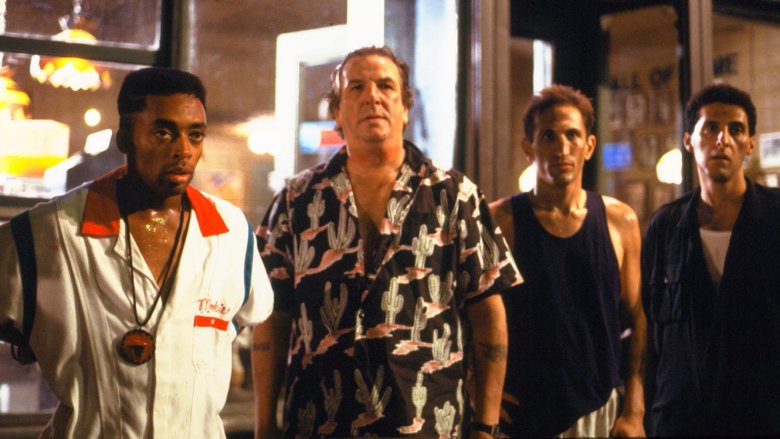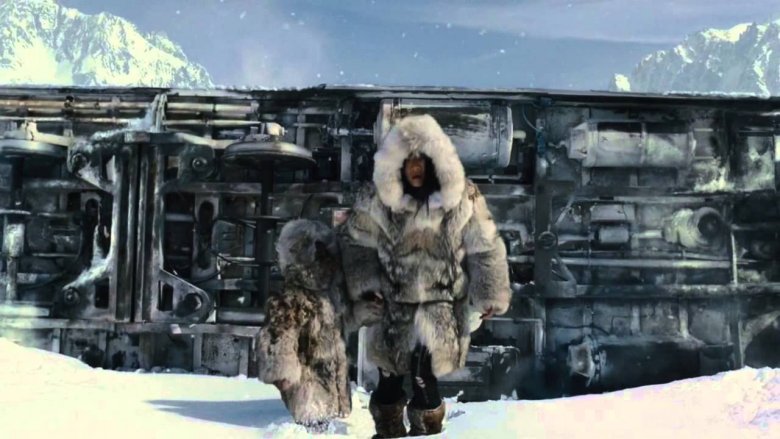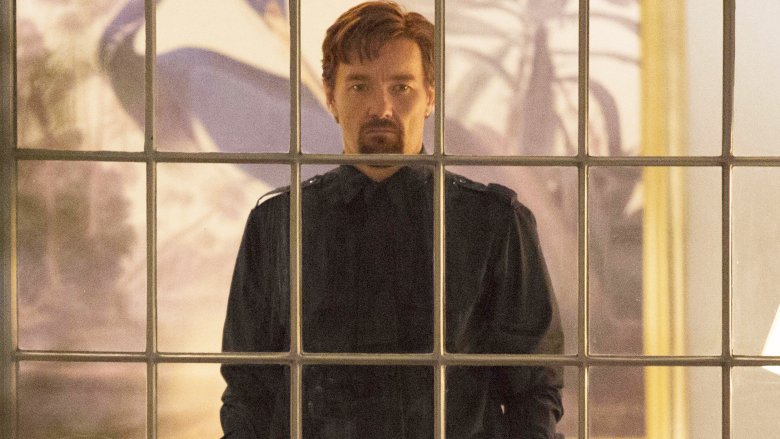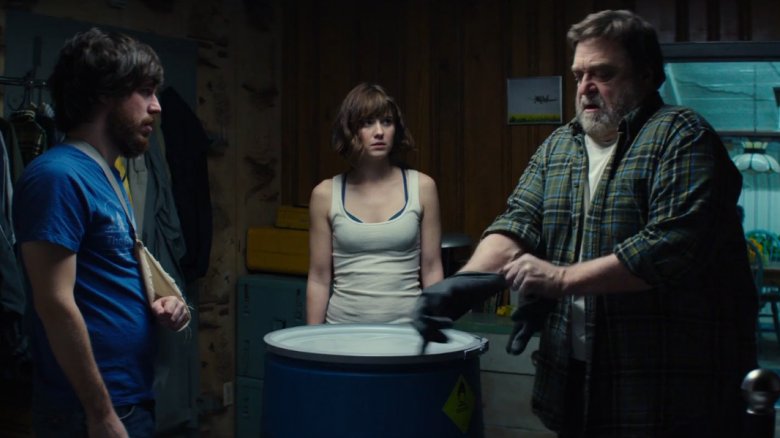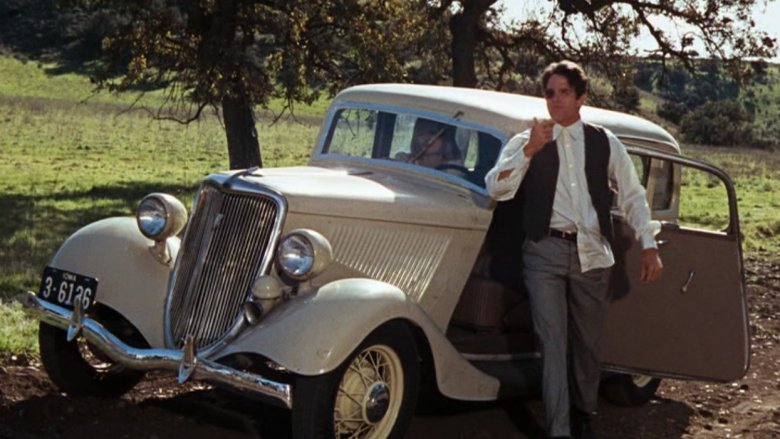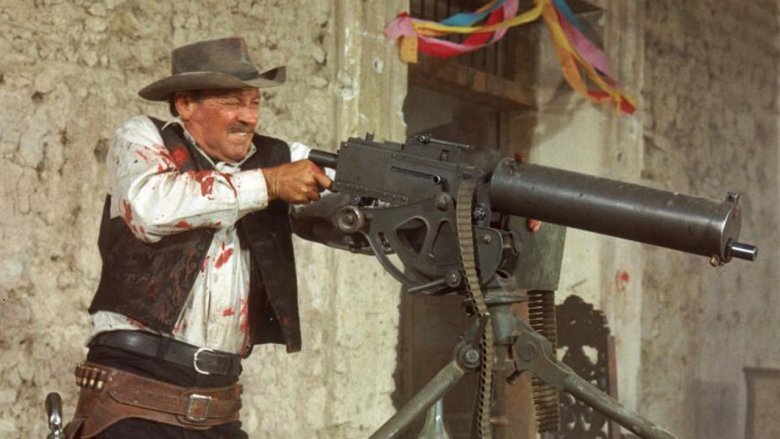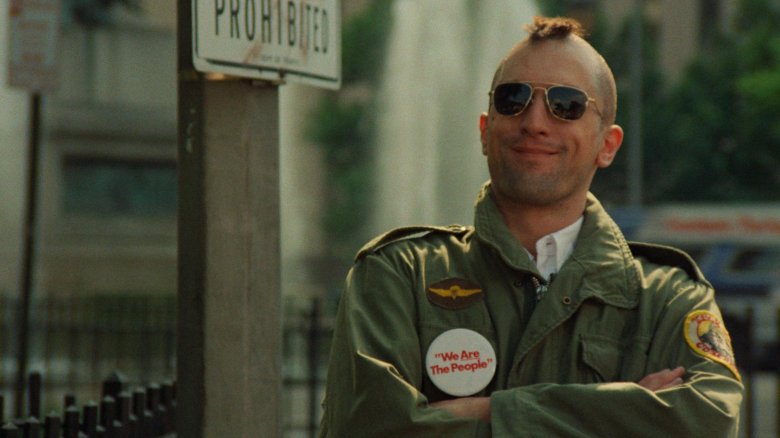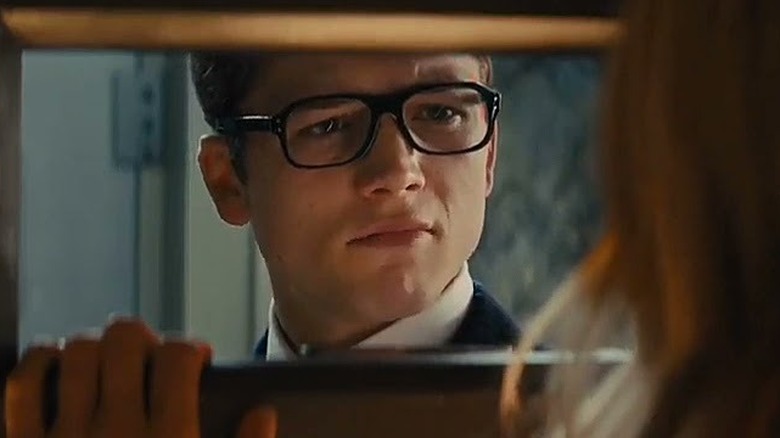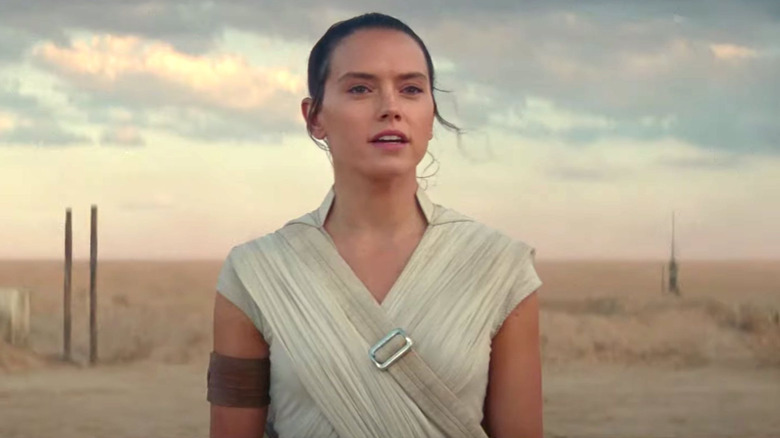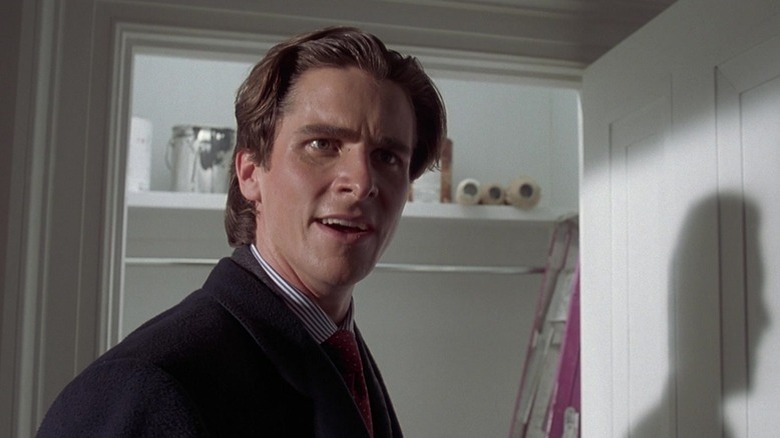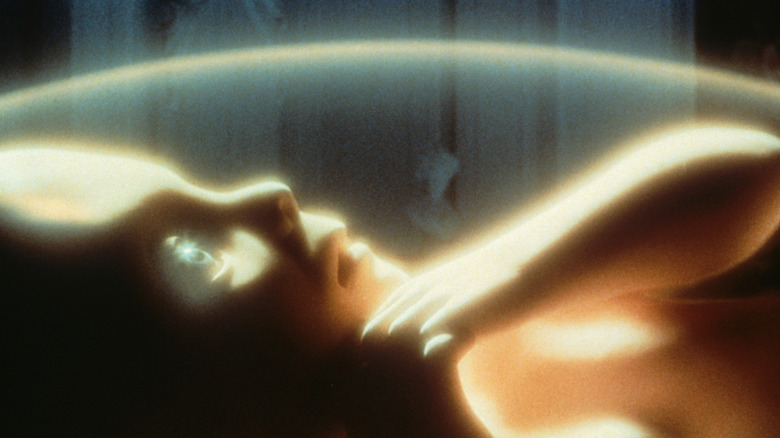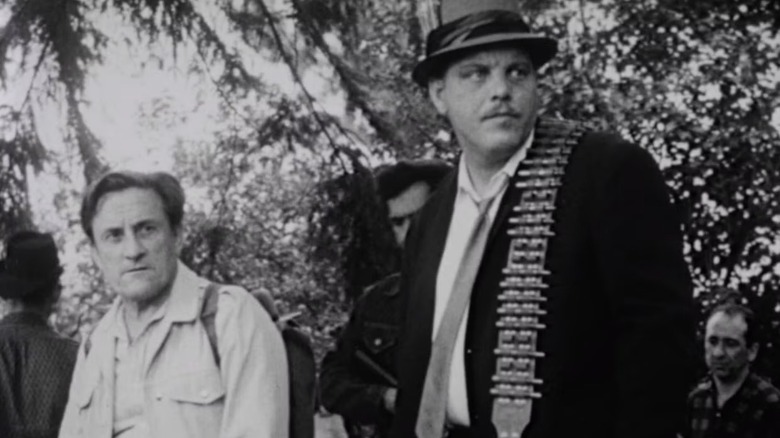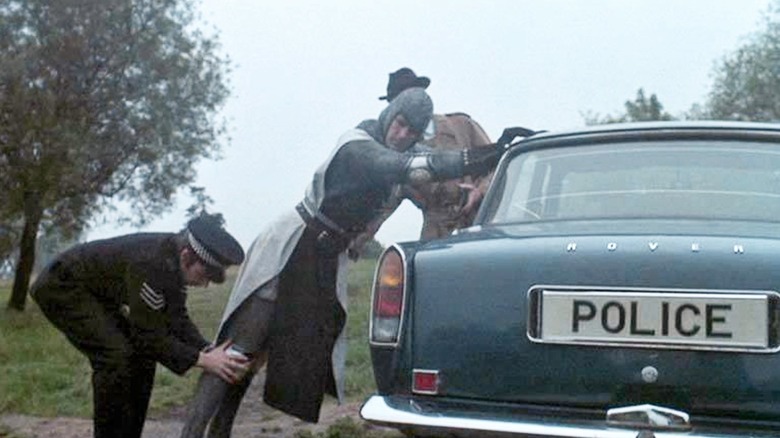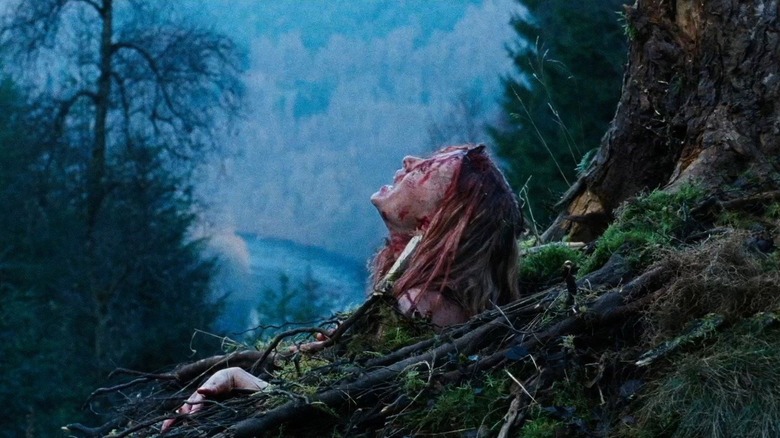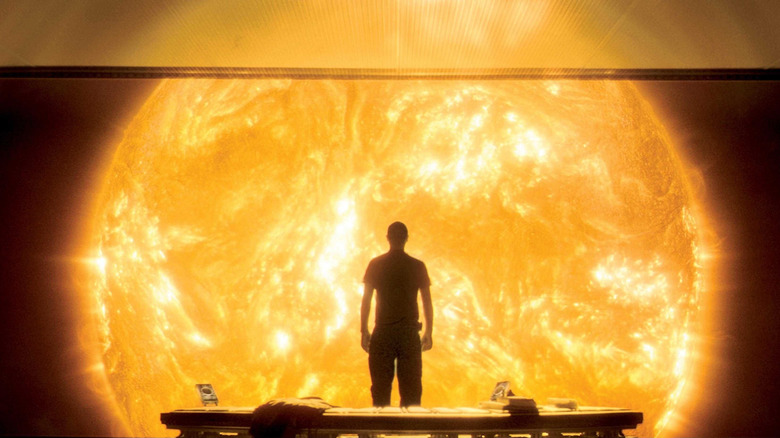The Most Controversial Movie Endings Of All Time
It's been said that you can please some of the people all of the time, all the people some of the time, but you can't please everyone all of the time. That's especially true for movie endings. Hollywood history is full of shocking finales that have left people confused, made moviegoers mad, or sparked fierce debate between critics. From decades-old films to modern-day blockbusters, here are some of the most controversial movie endings of all time. Major spoilers lie ahead, obviously.
The Hateful Eight (2015)
A Quentin Tarantino movie wouldn't be a Quentin Tarantino movie if it wasn't controversial, and when it comes to QT's filmography, his most contentious film is without a doubt "The Hateful Eight." This blood-soaked western follows eight — well, there are actually more than eight, but who's counting? — desperadoes trapped inside a cabin. Outside, there's a blizzard. Inside, there are a bunch of cutthroats all waiting to kill each other. One of these crazy crooks is Daisy Domergue (Jennifer Jason Leigh), an outlaw on her way to the hangman's noose ... that is, if her captors don't beat her to death first.
Throughout the movie, Domergue is repeatedly punched by men like John "The Hangman" Ruth (Kurt Russell), Major Marquis Warren (Samuel L. Jackson), and Sheriff Chris Mannix (Walton Goggins). In fact, at the end of the movie, Warren (a black Yankee) and Mannix (a white Rebel) put aside their political and racial differences to string Domergue up from the roof. As she's dancing midair, the two men laugh, enjoying their new jobs as executioners.
Needless to say, this last scene is disturbing as all get out, and multiple people have labeled the movie as misogynistic. After all, Domergue is abused throughout the movie, and the male characters take a lot of glee in lynching this female outlaw. On the other hand, Jennifer Jason Leigh defended Tarantino, claiming "he's the most female-centric director around," and there are also critics who appreciated the film and argued the violence against Domergue was meant as a comment on sexism in American society. Regardless of who's right, we're not planning on re-watching that final scene anytime soon.
Titanic (1997)
Sure, "Titanic" is still the second highest-grossing movie of all-time, but those billions of dollars couldn't save the film from the endless scrutiny of internet nitpickers. According to countless fans across the world, the ending of "Titanic" — one of the most romantic movies ever made — is nothing short of a disaster.
After the titular boat goes down, our starstruck heroes, Jack (Leonardo DiCaprio) and Rose (Kate Winslet), find themselves stuck in the freezing cold Atlantic. It's a dire situation, but things are bit worse for poor Jack. While Rose gets to float atop a detached door, Jack is partially submerged, his upper half leaning on the improvised life raft while his lower half slowly turns into a popsicle. Tragically, Jack passes away before help arrives, and this death scene sparked quite a bit of outrage. Wasn't there room on that piece of wood for the both of them? Did Jack die a pointless death?
The debate was so intense that in 2012, "Mythbusters" dedicated an entire episode to discovering the answer. With the help of director James Cameron, hosts Adam Savage and Jamie Hyneman determined that if Jack or Rose had tied a life jacket to the underside of the door, there would've been enough buoyancy to hold them both. But Cameron doesn't buy that argument, saying that, "The script says Jack dies, he has to die. Maybe we screwed up. The board should have been a tiny bit smaller. But the dude's going down."
The Mist (2007)
The ending of "The Mist" is one of the bleakest finales ever put to film, or as Haleigh Foutch of Collider put it, "The ending is often described as a gut punch, I'd say it's more of a kick in the balls—the worst pain you've ever felt mixed with curdling nausea."
Directed by Frank Darabont, "The Mist" focuses on a group of New Englanders trapped in a grocery store by a mysterious fog. The titular mist is full of horrifying monsters, but things ain't so great inside the store either. Once people start getting sacrificed, David Drayton (Thomas Jane) makes a break for freedom with a small band of survivors, but unfortunately, there's no happy ending here.
Lost in the mist with no hope in sight, David performs a mercy killing to spare his friends—and his own son—from the oncoming creatures. And then, seconds later, the Army shows up to save the day, only it's too late for poor David, who's left alone in the fog. Yeah, it's bleak, grim, and completely different from Stephen King's novella, but the author loved Darabont's twist, saying it was "the most shocking ending ever."
But not everyone was quite as pleased as King, and the controversy rages to this day. Chris Eggertsen of Uproxx recently compiled a list of tweets showing that people are still reeling from the final few minutes. "Ok," one person wrote, "but do we all agree that The Mist has the most effed up ending ever?" Another tweeted, "If anyone ever wants to witness the worst ending to a movie in all of existence watch 'The Mist.'" But whether you love or hate the movie, you've got to agree with the devastated Twitter user who wrote, "The ending of The Mist emotionally damaged me."
Watchmen (2009)
Even though Alan Moore's "Watchmen" is widely considered the greatest graphic novel ever written, it took quite awhile to get a movie adaptation up on the silver screen. At one point, Terry Gilliam took a crack at the material, but when that didn't pan out, it eventually fell to Zack Snyder to get the thing made.
The result was a film that was pretty faithful to the book ... except for one major change. In Moore's original story, the villainous Ozymandias destroys New York with an alien squid that he cooked up in a lab. The arrival of this bizarre monster convinces the world's superpowers that extraterrestrials are going to attack, forcing the US and the USSR to put aside their differences in order to face an otherworldly foe.
However, Snyder totally dropped the whole cephalopod angle. Instead, Ozymandias (Matthew Goode) frames the omnipotent Dr. Manhattan (Billy Crudup), tricking America and the Soviet Union into becoming friends to defeat the naked blue superhero. Naturally, this dramatic change angered quite a few comic book fans, prompting Sara J. Van Ness to label the fiasco "Squidgate."
According to Snyder—who acknowledges the ending was "the biggest knock against the movie"—the squid was cut out so more time could be spent building the characters of Manhattan and Rorschach (Jackie Earle Haley). And while it's true that the ending has its defenders (including Patton Oswalt), the Dr. Manhattan frame-up didn't sit right with quite a few fans, many of whom probably decided against watching the Watchmen.
The Dark Knight Rises (2012)
Christopher Nolan's "Dark Knight" trilogy was a game-changer for superhero movies, and its Joker-heavy second installment was beloved by every Batfan on the planet. In other words, "The Dark Knight Rises" had a lot to live up to. But instead of diving headfirst into the darkness, the third Nolan film ended on a much happier note, with the Caped Crusader (Christian Bale) saving Gotham from a nuclear bomb before giving up his vigilante ways to travel the world with Selina Kyle (Anne Hathaway).
As a result, many fans wondered if this was some sort of "Inception"-style dream sequence. After all, the scene plays out exactly like a fantasy described by Alfred (Michael Caine) earlier in the film. The actors, on the other hand, insist Batman's happy ending is completely real, with Bale insisting, "No, it was not a dream."
Others thought the movie should've gone in a more depressing direction by killing the superhero. But for every person who wanted Batman to die in a fiery explosion, there was a fan who was glad that Bruce Wayne finally got a happy ending. And really, as Kevin P. Sullivan of MTV points out, we shouldn't have been surprised by the film's upbeat finale because — as Harvey Dent once explained — the night is darkest just before the dawn.
Star Trek II: The Wrath of Khan (1982)
Directed by Nicholas Meyer, "Star Trek II: The Wrath of Khan" features one of the saddest death scenes you'll ever see in a sci-fi movie. After going toe-to-toe with Khan Noonien Singh (Ricardo Montalban), the crew of the USS Enterprise is in serious trouble. There's a super weapon about to go off, and Captain Kirk (William Shatner) can't escape the blast in time because the ship's warp drive has been seriously damaged. And that's when Spock (Leonard Nimoy) decides to save the day.
Putting the needs of the many ahead of the needs of the few, Spock exposes himself to deadly radiation in hopes of repairing the ship. While his plan works out and the Enterprise escapes intact, our pointy-eared hero dies a tragic death, separated from Kirk by a pane of glass. It's a heartbreaking scene, and if you're not getting a bit misty-eyed right now, it's probably because you're a Vulcan. Of course, fans back in 1982 weren't just upset about Spock's demise. They were downright furious.
News of Spock's death leaked pretty early during the filming of "Wrath of Khan," resulting in a major outcry from fans. According to executive producer Harve Bennett, the filmmakers received "a hundred thousand letters" pleading for Spock's life. One Trekkie took out a magazine ad demanding that Paramount spare the Vulcan, and some fans were so upset that they started harassing Leonard Nimoy, actually threatening the man and his family.
Hoping to throw fans off, Meyer and company added a scene early in the film in which Spock fakes his death during a training sequence, and honestly, that probably only made it hurt even more when the Vulcan finally gave his trademark salute for the final time ... well, until "Star Trek III: The Search for Spock" came out, anyway.
The Grey (2012)
When Liam Neeson fans went to check out "The Grey," they totally expected to see their boy throw down with a bunch of wolves. That's what the trailer promised, after all. But instead of seeing an epic showdown between man and beast, viewers were left with a far more ambiguous ending, one that sent packs of people howling from theaters.
Set in Alaska, "The Grey" follows a hunter named John Ottway (Neeson) who's stranded in the wilderness with a group of oil workers. While he starts the movie suicidal, Ottway slowly regains the will to live, which is too bad since he winds up in the middle of a wolf den. Ready to fight, Ottway grabs a knife and tapes broken bottles to his hand, but before the final confrontation, the screen cuts to black.
Audiences were sharply divided. On one hand, there were people like Nordling of Ain't It Cool News who thought the wolf battle would've been anticlimactic as the movie has already reached its real ending with Ottway deciding to live. "The whole point of the film," he writes, "is about a man staring death in the eye and having the courage to fight when he knows he won't win." But others weren't so forgiving, like the viewer who wrote, "I wasted my two hours and $10, the very least you can give us a definitive answer."
As for director Joe Carnahan, he cut the finale because the film had already reached its "emotional conclusion," and he also worried that the CG canines might ruin the scene. However, Carnahan admits the promotional material "was the enemy of the film in a lot of ways. I guess it created a promise that people felt the movie didn't live up to."
The Devil Inside (2012)
Nobody likes "The Devil Inside." Visit the film's page on Rotten Tomatoes, and you'll find the film has a measly six percent approval rating (which means there are a few critics out there possessed by spirits with very bad taste). In fact, when the film hit theaters in 2012, there were multiple reports that audience members began jeering and shouting in anger after the credits started rolling. So what kind of ending would cause moviegoers to unleash their inner demons?
Well, "The Devil Inside" is a found footage film about killer named Maria Rossi (Suzan Crowley), a woman who's possessed by four demons. Her daughter, Isabella (Fernanda Andrade) is making a documentary about her murderous mom, and eventually, the film culminates with an exorcism where the demons decide to leave their host and inhabit our heroes. As a result, things take an unfortunate turn as Isabella and her friend are speeding down a busy highway. Suddenly, her possessed buddy turns into oncoming traffic, and the movie cuts to black.
And that's when a title card pops up, reading, "The facts surrounding the Rossi case remain unresolved. For more information about the ongoing investigation, visit www.TheRossiFiles.com." Really, the site was just a bizarre bit of viral marketing, but moviegoers thought they would have to visit the site to find out how the story ended. That wasn't actually the case, but nevertheless, people felt cheated, prompting a whole lot of outrage from furious horror fans. "The audience in the screening I was at actually booed," wrote Annalee Newitz of io9. "It felt like we'd just watched an 85 minute teaser ad for a website. Which I guess we had."
Safe Haven (2013)
Based on the novel by Nicholas Sparks, "Safe Haven" has a measly 12 percent approval rating on Rotten Tomatoes, and a lot of that hatred has to do with an ending that comes straight out of "The Sixth Sense." Supposedly set in the real world—you know, a place where ghosts don't exist—this 2013 romance focuses on a battered wife named Katie (Julianne Hough). She's on the run after stabbing her husband, and she eventually winds up in a new town where she befriends a local woman named Jo (Cobie Smulders) and falls in love with a hunky widower named Alex (Josh Duhamel).
As you've probably guessed, Katie and Alex wind up together, but moments before the credits roll, the couple discovers a stack of letters written by Alex's dead wife, Carly. They also find a photo of his old flame, and surprise — she looks exactly like Cobie Smulders.
Yeah, that's right. Katie's friend Jo is the ghost of Alex's wife, returned from the afterlife to play matchmaker for her hubby. As twists go, this one is completely nuts, especially considering there weren't any apparent supernatural elements in the movie until the end. In fact, the finale was so bonkers that Matt Neal of The Standard wrote that the twist "will make you want to punch the movie in the face."
Stephen Whitty of the Newark Star-Ledger had an equally angry reaction, saying, "If you have any popcorn left by the scene, you'll want to throw it at the screen." And Richard Roeper, always ready for a good burn, wrote, "If it can be said movie have personalities, I give you three words to sum up the basic core identity of 'Safe Haven.' Bat. Bleep. Crazy."
The Interview (2014)
Directed by Seth Rogen and Evan Goldberg, "The Interview" follows a talk show host (James Franco) and his producer (Rogen) as they visit North Korea to, well, interview Kim Jong-un (Randall Park). But before they reach Asia, they're recruited by the CIA to assassinate the dictator. Initially reluctant, they finally do the deed when Kim decides to launch his nuclear weapons. As Kim sits in a helicopter, Franco and Rogen blast him to kingdom come with a tank, and we watch in slow-mo as the bad guy's face catches on fire.
Originally, Kim's death was way more violent. His entire head exploded, sending "chunks of skull" everywhere. This did not sit well with Kazuo Hirai, the CEO of Sony, who insisted that Rogen tone down the gore. But that was just the start of what would become an international incident. The madness really began when North Korea stated that releasing "The Interview" would be an "act of war." Things only got worse when a North Korean-backed group called the Guardians of Peace hacked Sony, began releasing private emails, and demanded the studio shut down the controversial comedy.
And this is where things got kind of scary. The Guardians of Peace followed up their hacking attack with terrorist threats, promising to remind Americans about "the lessons of the 11th of September, 2001." As a result, five major theater chains decided to drop "The Interview," and Sony initially declined to release the movie online. Sure, the movie eventually did make its way into theaters and streaming services — where people quickly discovered "The Interview" wasn't all that funny — but it's kind of weird to think that decades from now, film students will still be talking about how a Seth Rogen movie sparked an international incident.
Blade Runner (1982)
George Lucas often gets flack for making changes to the original "Star Wars" trilogy, but if we're going to criticize Lucas, then we also need to point the finger at Ridley Scott. After all, there are seven different versions of "Blade Runner," and thanks to all that tinkering, sci-fans have spent countless hours discussing whether or not Rick Deckard (Harrison Ford) is actually a replicant.
So what's the correct answer? Well, if you go by the original ending, it's a straightforward "no." The theatrical cut ends on an upbeat note, with Deckard and his robotic lady love (Sean Young) escaping into the mountains to live a long and happy life. There's no origami, no unicorn, and only one android.
However, that all changed with the Director's Cut. That's the version in which Scott added Deckard's unicorn dream and cut the happy Hollywood ending. This time around, the film ends with our protagonist finding Gaff's (Edward James Olmos) origami message, possibly implying the creepy cop knows what Deckard dreams about because Deckard's memories are implants, thus making him a replicant.
Ever since, people have argued about Deckard's true nature. Even Ridley Scott and Harrison Ford don't agree. The director firmly believes Deckard is a machine, while the actor claims his character is 100 percent human. Those who side with Scott think the replicant ending adds a layer of darkness, mystery, and complexity. But those who agree with Ford — like Red Letter Media's Jay Bauman — believe the replicant theory ruins the whole movie. Why does it matter if Deckard rediscovers his humanity if he's not actually human?
Regardless of which side of the debate you fall on, we can all agree "Blade Runner" is an incredibly influential film, and however people feel about Denis Villeneuve's 2017 sequel, they'll continue talking about the original's ending(s) for a long, long time.
Passengers (2016)
On paper, "Passengers" should've been one of the biggest blockbusters of 2016. It starred Chris Pratt and Jennifer Lawrence — two of the biggest stars in the business — and it was based on a screenplay by Jon Spaihts that many hailed as one of the best scripts in Hollywood. On top of all that, the trailers promised a love story set in space, but the sci-fi flick was a major flop, grossing only $100 million domestically on a $110 million budget. So what went so terribly wrong aboard "Passengers?"
Well, moviegoers were expecting to see a story about two beautiful people who accidentally wake up from suspended animation while traveling to a new planet. Unable to return to their pods, the two are fated to spend their lives together on this spaceship, and soon, the two strike up an intergalactic romance. But the trailers were more than slightly misleading. As it turns out, Pratt's character (Jim) wakes up after his pod malfunctions, and unwilling to spend his life alone, he releases Lawrence's character (Aurora) against her will.
Admittedly, the movie could've done something interesting with this premise, but instead of dealing with Jim's decision in a mature, complex way, the filmmakers have Aurora fall in love with the guy and decide to spend her life with him ... even though she finds a way to escape her fate, even though he's essentially kidnapped and murdered her. As a result, critics hit the movie hard, and audiences stayed away from theaters. Instead, irate film fans took to social media and labeled "Passengers" as "creepy," dooming the movie to a lonely existence without anyone in the audience.
Monty Python's Life of Brian (1979)
Want a surefire way to stir up controversy? Make a movie about Jesus. It worked for Mel Gibson, Martin Scorsese, and of course, Monty Python. Okay, technically "Life of Brian" isn't about the Son of God. Instead, it's about a guy named Brian (Graham Chapman) who's mistaken for a messiah and, as a result, winds up hanging on a cross. And while our reluctant hero dies a painful death, the movie launches into a musical number, with rows of crucified convicts singing the upbeat "Always Look on the Bright Side of Life."
Needless to say, "Life of Brian" made some people pretty upset. Protesters sang hymns outside movie theaters. The film was banned in both Norway and Ireland. The Catholic Church rated it "C" for "Condemned," making it a sin for the faithful to watch. One high-profile priest claimed the ending had turned the cross into "something intolerable," and even politicians got into the act, with a Georgia judge trying to stop theaters from showing the film and Senator Strom Thurmond pulling some strings to get the movie axed in South Carolina.
As a response to the outcry, John Cleese and Michael Palin went on a British TV show to defend the film, debating the movie's merits with a Catholic bishop named Mervyn Stockwood and broadcaster Malcolm Muggeridge. The Pythons claimed the movie wasn't a mockery of Christ but a satire on organized religion. Muggeridge, on the other hand, slammed the film as an assault on Jesus' death. But despite the notoriety — or more likely because of it — "Life of Brian" has become a comedy classic, although Cleese cheekily admits that, "Four hundred years ago we'd have been burnt for 'Brian.'"
Do the Right Thing (1989)
"Do the Right Thing" came out nearly 30 years ago, but it's just as relevant today as it was in 1989. Set during a vicious summer heat wave in New York City, this Spike Lee joint focuses on a small neighborhood divided by race. The film takes place over the course of a single day, and we watch as an argument between a white pizza shop owner (Danny Aiello) and two Black customers (Giancarlo Esposito and Bill Nunn) escalates into a violent showdown.
The madness starts when an NYPD officer murders a young African-American man. In response, the main character (played by Lee) starts a riot that destroys the aforementioned pizza parlor. It's a devastating climax, one that leaves audiences shaken to the core but empathetic toward all the characters and where they're coming from.
Well, that's what was supposed to happen anyway. Unfortunately, a lot of people misunderstood the movie and worried "Do the Right Thing" would incite real-life riots. "The end of this movie [is] a shambles," wrote David Denby of New York Magazine, "and if some audiences go wild, he's partly responsible." Joe Klein (also of New York Magazine) wrote that if Black people "react violently — which can't be ruled out," it might hurt the chances of NYC mayoral candidate David Dinkins, who was African-American. And Jack Kroll of Newsweek worried how Black moviegoers would "react to the climactic explosions of interracial violence."
Naturally, this didn't sit well with Lee, who pointed out that critics never said "people were going to come out of theaters killing people after they watched Arnold Schwarzenegger films." He also took critics to task for assuming that Black audience members couldn't "tell the difference between what's on screen and what's in real life."
Snowpiercer (2014)
Directed by Bong Joon-ho, "Snowpiercer" is set in the middle of a wintry post-apocalypse, with the last of humanity on a train that travels around the world. Unfortunately, living conditions aren't great for those in the back. Folks in the tail end are treated like prisoners, while the people in the front live like kings. Wanting to shake up the system, a group of rebels — led by Curtis (Chris Evans) — fights their way up to the front of the train, hoping to overthrow Wilford (Ed Harris), the all-powerful engine.
But when Curtis makes his way into the engine, he learns the train operates using child slave labor. Realizing the entire system is corrupt and impossible to save, Curtis and his compatriots destroy the "Snowpiercer," possibly killing everyone on board, except for two kids. Emerging from the rubble, a teenage girl and a young boy find themselves Adam and Eve of a frozen world, free from Wilford's control. And as they step into the snow, they see a polar bear, a sign the world is thawing out and that maybe there's hope after all.
Well, that's what Bong Joon-ho intended anyway, but many people had trouble getting past certain plot holes. As one incredulous Reddit critic wrote, "A girl and a kid that lived in a sheltered environment their whole life and don't know how to hunt or gather in the snow ... I give them a couple of days tops." Another angry moviegoer wrote, "They will be eaten [by the bear] and the human race dies out." There are countless other online comments picking the ending to pieces, but really, overanalyzing "Snowpiercer" is like debating the logic of a C.S. Lewis novel or "Pilgrim's Progress," as this sci-fi flick is supposed to work as one big allegory.
The Gift (2015)
Directed by Joel Edgerton, "The Gift" is a creepy little thriller with a queasy little ending. The movie follows married couple Robyn (Rebecca Hall) and Simon (Jason Bateman) as they move into a new neighborhood and bump into Gordo (Edgerton), an old acquaintance of Simon's. Simon and Gordo once attended the same school, and it's been awhile since they've seen each other, probably because Gordo is an absolute creep.
In fact, after their chance meeting, Gordo starts stalking the couple, but even though he seems to be a menacing monster, Simon isn't such a great guy either. See, back in high school, Simon intentionally ruined Gordo's life, just for fun, and now Gordo wants revenge. The plot takes a left turn straight into Sleaze Town when a pregnant Robyn suddenly goes into labor. After taking his wife to the hospital, Simon discovers a recording of Gordo drugging and getting ready to rape Robyn — implying that Simon's new kid might actually be Gordo's.
It should come as no surprise that many critics were outraged by this uncomfortable twist, partly because of fatigue over filmmakers using rape as a shock tactic, and partly because the ending turned an otherwise strong female character into a sexual object for guys to fight over. As A.A. Dowd of The A.V. Club put it, Robyn has become "collateral damage in the war between these two men," and it gets even worse as the movie doesn't stop to consider Robyn's reaction to her possible assault (if she ever finds out, anyway). Instead, it only focuses on how Simon handles the news.
On the more practical side of things, Jason Bailey of Flavorwire notes that a DNA test could solve this conundrum pretty easily, but nit-picking aside, the moral of "The Gift" is pretty simple: Hollywood should be a little more thoughtful when it comes to using sexual assault as a twist ending.
If you or anyone you know has been a victim of sexual assault, help is available. Visit the Rape, Abuse & Incest National Network website or contact RAINN's National Helpline at 1-800-656-HOPE (4673).
10 Cloverfield Lane (2016)
When "10 Cloverfield Lane" arrived in 2016, people wondered if this sci-fi flick would have any connection to the Matt Reeves/J.J. Abrams monster movie that'd come out eight years before. Was it a sequel or a prequel? Did it take place in the same universe? Would there be any aliens? As moviegoers quickly found out, there were most definitely aliens—but not everyone was happy when the evil ETs showed up onscreen.
The space worms first appear after our hero Michelle (Mary Elizabeth Winstead) escapes from an underground bunker. For most of the movie, she's been held captive by Howard (John Goodman), a murderous conspiracy theorist who thinks aliens have taken over the world. And when Michelle finally makes her way to the surface, she discovers Howard was right. Seconds after defeating her warden, Michelle is forced to fight against invaders from another galaxy, and after destroying a UFO with a Molotov cocktail, she chooses to join the human resistance and fight the otherworldly army.
This fiery finale ticked off quite a few moviegoers, as many thought the climax was overblown and out of place. Some said the movie "self-destructed" in the last few minutes, while others argued Michelle didn't need to fight any extraterrestrials as she'd already beaten Howard. On the other hand, film critic Tasha Robinson and director Dan Trachtenberg say the scene is essential for Michelle's character arc. Now that she's seen the alien foe up close, her decision to join the resistance has real meaning. She now knows from firsthand experience what dangers lie ahead, so when she drives toward the invasion, we understand she's finally overcome her fear, and she won't run away this time.
But regardless of your opinion on the ending, can we all agree that John Goodman was way scarier than any alien?
Bonnie and Clyde (1967)
The year 1967 was a pretty big deal for cinema, thanks to the double whammy of "The Graduate" and "Bonnie and Clyde." The Dustin Hoffman-Anne Bancroft movie revolutionized on-screen sex, and the Warren Beatty/Faye Dunaway flick revolutionized on-screen violence. While tame by today's standards, "Bonnie and Clyde" was a bloodbath back in '67, with squibs sending bursts of red and bits of flesh flying into the air. Things got especially gory during the climax, when Bonnie (Dunaway) and Clyde (Beatty) are gunned down by a posse armed with machine guns.
Director Arthur Penn wanted to make the scene as realistic possible, pointing to the Vietnam War when he told NPR, "It was a time where, it seemed to me that if we were going to depict violence, then we would be obliged to really to depict it accurately; the kind of terrible, frightening volume that one sees when one genuinely is confronted by violence." And thanks largely to that final massacre, "Bonnie and Clyde" sparked a firestorm in Tinseltown, prompting Roger Ebert to write, "You'd probably have to go back to 'Psycho' (1960) to find another Hollywood film that has generated such intense debate."
The main guy who opposed the film was Bosley Crowther of The New York Times, probably the most powerful film critic in America. He dedicated the next several months of his career to attacking the film at every available opportunity, writing, "This blending of brutal killings is as pointless as it is lacking in taste, since it makes no valid commentary on the already travestied truth." But Crowther couldn't stop progress, and "Bonnie and Clyde" set the template for future films like "The Wild Bunch," "A Clockwork Orange," and every Quentin Tarantino movie ever made.
The Wild Bunch (1969)
Moviegoers who thought "Bonnie and Clyde" was too intense were in for a shock when they sat down to watch Sam Peckinpah's bullet-riddled western "The Wild Bunch." The movie is bookended by two beautifully gory gunfights, and in 1969, the final showdown between the titular outlaws and a band of Mexican soldiers was possibly the most violent scene ever to come out of mainstream Hollywood.
The climax took nearly two weeks to film and involved around 10,000 squibs, each one loaded with actual meat. In addition to the geysers of blood and chunks of flesh flying through the air, the gunfight also involved women getting shot and kids killing adults, none of which sat well with many of the people who attended the film's first screening. Angry audience members left behind notes that read "Would suggest you rename it 'Bath of Blood'" and "Only a madman could call this creation!"
When Warner Bros. screened the movie for critics at an international film festival, the audience's reaction was divided. Things got a little a testy at the following press conference, with one incredulous journalist asking Peckinpah, "Why was this film ever made?" Then the MPAA threatened to slap the film with an "X" rating, forcing the director to make some cuts. Worse still, when the movie was re-released in the early '90s, the ratings board considered giving it an NC-17 before agreeing to let the western keep its original R. Still, the incident helped cement "The Wild Bunch's" legacy as one of the most controversial movies ever made, and in a way, it's still generating debate today by inspiring ultra-violent directors like Quentin Tarantino.
Taxi Driver (1976)
In addition to giving us one of the all-time classic movie lines, "Taxi Driver" also provided film fans with one of the most hotly debated finales in cinematic history. It all starts when Travis Bickle (Robert De Niro) quits his cab driving job to become a full-time assassin. The wannabe murderer has plans to shoot a high-profile politician, but when that doesn't pan out, he heads to a local brothel, hoping to go out in a blaze of glory.
As Travis blasts his way through the bordello, he takes quite a few bullets himself. When the police finally show up, our mohawked anti-hero is lying on the ground, covered in blood. But instead of going to the morgue, Travis actually survives the shootout and becomes a New York City superhero...right? Well, some wonder whether the last few minutes of the film are actually some sort of fantasy Travis is having moments before death, the taxi driver's last dream before fading away forever. While it's an interesting theory, screenwriter Paul Schrader couldn't disagree more. In a commentary track, he explains the ending was inspired by Sara Jane Moore, a woman who tried to kill President Gerald Ford and wound up on the cover of a magazine. Shocked at how easy it was for criminals to grab the spotlight, Schrader decided to critique modern-day society by crafting an ending where Travis actually becomes a hero.
However, Schrader also believes that it's only a matter of time before Travis strikes again. Martin Scorsese actually agrees with Schrader's take, although the screenwriter admits "good movies leave themselves open for interpretation." So did Travis survive, or did he die? The answer depends on whether or not you think we live in a world where psychos can become celebrities.
Kingsman: The Secret Service (2014)
Filmmaker Matthew Vaughn has been something of an unsung hero in the comic book movie space, directing both cult hit "Kick-Ass" and the excellent soft reboot "X-Men: First Class." Most recently, he directed and co-wrote the "Kingsman" trilogy, based on the comic series of the same name. It kicked off with 2014's "Kingsman: The Secret Service," a fun spy action romp that wears its James Bond inspirations on its sleeve so openly that it's a wonder nobody got sued. Fairly modestly budgeted for the impressive action and set pieces on display, "The Secret Service" did very well at the box office and mostly won critics and audiences over. That is, except when it came to the movie's unfortunate ending.
At first, it seems like things are going to go fairly traditional — the hero, Eggsy (Taron Egerton), saves the day and gets to kiss the princess (Hanna Alström). But the princess promised something much more than a kiss. Yes, we're talking about sex, but not just any sex. We really can't elaborate, but it's not the kind of intercourse that's typically discussed in a major studio movie. And sure enough, in the final moments of the movie, it is made very clear that the princess is about to be taken up on her raunchy offer.
After receiving the expected backlash for the ending, Vaughn argued that he was not only simply continuing in the tradition of 007 movies that ended with extremely innuendo-laden lines, but was trying to be pro-feminism by letting it be a woman saying such a line instead. But the damage had been done, with that decision leading to "The Secret Service" being included on many lists of great movies tainted by bad endings.
Star Wars: The Rise of Skywalker (2019)
The "Star Wars" fandom can be a passionate bunch, to say the least. So to say that the ending of a "Star Wars" movie had fans literally screaming in frustration in theaters doesn't necessarily move the needle on the discussion of controversial movie endings. But with that being said, the way the third installment of the sequel trilogy, and ninth mainline "Star Wars" movie overall, drew to a close might have taken things to a whole new level.
Things started out promisingly enough with "The Force Awakens," seeming to repair a lot of the lost confidence that fans had in the "Star Wars" films after the prequel trilogy. However, it didn't take long for things to go off the rails, with the story going in all kinds of obtuse and scattershot directions as the sequel trilogy went on. Clearly, the "Star Wars" brain trust just didn't know what to do with most of these characters, and both legacy icons and sequel introductions largely saw unsatisfying conclusions.
Well, when all else fails, add yet another Skywalker to the mix! The very last moment at the very end of not only "The Rise of Skywalker" but the entire sequel trilogy saw Rey (Daisy Ridley), who had already been established to be part of the Palpatine family, anoint herself as "Rey Skywalker" instead. Rather than see the moment as a touching way for Rey to favor her chosen family over her blood family, fans were not having it. Many pointed out the way that it not only undermined everything the sequel trilogy had established story-wise, but actually failed Rey as a character.
The Graduate (1967)
"The Graduate" is one of those movies that you might feel like you've seen even if you haven't. It's been endlessly quoted, discussed, parodied, and paid tribute to over the decades since its release. But the movie is a lot more than the subplot that Paul Finch (Eddie Kaye Thomas) and Stifler's mom (Jennifer Coolidge) reduced it to in "American Pie." Especially since, in "The Graduate," it turns into a love triangle between Benjamin Braddock (Dustin Hoffman), Mrs. Robinson (Anne Bancroft), and Mrs. Robinson's daughter, Elaine (Katharine Ross).
Then there's that controversial ending. After Benjamin (Dustin Hoffman) crashes the wedding of Elaine (Katharine Ross) and her new beau Carl (Brian Avery), Benjamin convinces Elaine to run off with him instead. At first, the two seem giddy at being able to take another chance at a relationship. But as they sit on the back of a bus together, the excitement soon melts off their faces as they simultaneously realize the gravity and of what they've just done and all the baggage that is going to come with their future together. The film ends with Benjamin and Elaine looking sullen, as Simon & Garfunkel's "The Sound of Silence" kicks in to reinforce that this is anything but the start of a happily ever after.
Now, it must be stated that "The Graduate" was a controversial movie anyway, given that it's about infidelity, power imbalances, romantic age gaps, and a man who is seeing a mother and daughter simultaneously. But those who went on the journey with Benjamin and Elaine at least wanted to see them finally get together in the end. So when it was left up to ambiguity if that even ended up happening, a lot of people felt cheated — no pun intended.
American Psycho (2000)
There is a certain type of movie protagonist designed to be rooted against, and yet people often completely miss the point and idolize them anyway. One of the more frightening examples is Patrick Bateman (Christian Bale) of "American Psycho," who somehow has fans despite being a literal cold-blooded murderer. Or is he? And therein lies the issue with the movie's ending.
Over the course of the film, there are 12 murders that we actually see occur. And several of them happen in Patrick's own apartment, committed in such a way that a few sprays of Lysol and some rags won't suffice in cleaning up the mess. Eventually, Patrick calls and confesses to his lawyer that he has killed upwards of 40 people. But when Patrick sees his lawyer in person, his lawyer laughs the whole thing off, and strangely even offers up an alibi that disproves one of the murders. Later, Patrick goes to clean the apartment where he brutally murdered his co-worker, but he not only finds the apartment to be both completely clean and empty, but a realtor showing the apartment who denied that the aforementioned co-worker ever even lived there.
Implying that everything was just a figment of Patrick's twisted imagination already felt disappointing to many of the people who saw "American Psycho." But what made things even more controversial is that both director and co-writer Mary Harron, along with her fellow co-writer Guinevere Turner, have insisted that Patrick didn't dream it all up and that he really did commit all those grisly acts. As Harron explained to Charlie Rose, "I just got the emphasis wrong [...] It makes it look like it was all in his head, and as far as I'm concerned, it's not."
2001: A Space Odyssey (1968)
Stanley Kubrick's fairly small body of work consists almost entirely of movies that were controversial for one reason or another. A single director being able to include "Lolita," "A Clockwork Orange," "Full Metal Jacket," and "Eyes Wide Shut" in their filmography is impressive in and of itself. But even among Kubrick's films that weren't especially controversial as a whole, there are typically at least a few details that rub audiences the wrong way. And in the case of "2001: A Space Odyssey," it's the ending.
In fact, it's not just the actual ending of "2001" that has confounded audiences for over 50 years, it's the entire final half hour. Up to that point, the movie is a fairly straightforward sci-fi story about a space crew that finds themselves increasingly at odds with their ship's talking computer system. That is, if we ignore the beginning scenes that show prehistoric humans reacting to finding a giant alien monolith — or at least, we forget about it as the movie goes on, as most people do the first time they watch it.
But then that final stretch kicks in, and the movie turns into a mind-bending psychedelic freakout of lights, colors, and obtuse imagery. It all culminates in what appears to be the movie's main character being reborn as a giant space fetus. And thus, yet another movie finds itself in discussion after discussion of movies that were great until they were ruined by their failure to stick the landing.
Night of the Living Dead (1968)
While not the first-ever zombie movie — they had existed since at least the 1930s — George A. Romero's groundbreaking 1968 classic "Night of the Living Dead" laid most of the groundwork for the genre as we know it today. It also helped to blaze the trail for horror cinema as a whole. This would especially prove true for the generation of horror filmmakers that would immediately follow, utilizing Romero's approach of a small, modestly-budgeted, scrappy production to push more boundaries.
As a whole, the legacy of "Night of the Living Dead" is that it's not only a horror classic, but has still largely held up. But it obviously wasn't without its controversy when it was first released — though not entirely for the reasons you might expect. Sure, a certain segment of the viewing public wasn't ready for a movie about grotesque undead creatures, the gory mayhem they cause, and the brutal way in which they must be dispatched. But what really ruffled feathers is when "Night of the Living Dead" seemed to throw a message about racism into its final moments.
When everything seems to be handled and the movie is about to have a relatively happy ending, main protagonist Ben (Duane Jones) is unexpectedly shot to death alongside the remaining few zombies — despite there being zero indication that he was a zombie or turning into one. Many theorize that it was because he's a black man, and that the white men who shot him just saw a reasonable excuse to murder a black man. But even among those that don't think that racial overtones were meant to be implied by the ending, having the hero killed at the very end of the movie was still a shocking moment, and not appreciated by some viewers.
Monty Python and the Holy Grail (1975)
Even though it might seem in retrospect like the world would've been chomping at the bit for a Monty Python movie back in the 1970s, "Monty Python and the Holy Grail" famously had trouble procuring the financing it needed. In fact, the comedy troupe had to appeal to some of their famous friends, like The Beatles' George Harrison as well as members of Pink Floyd and Led Zeppelin, to reach into their pockets and help pay for the film.
Since the movie not only got released but went on to become a certified comedy classic, "Holy Grail" obviously got enough money to get itself made. But that's not to say that concessions didn't have to be made. Luckily, the Pythons were able to turn a lot of those concessions into comedy gold. For instance, having men bang together coconuts to mimic the sound of horses was the result of not having the budget to have real horses — but watching the movie, it just felt like Monty Python being Monty Python and something that was always part of the script.
Along those same lines, the budget for "Holy Grail" didn't allow for the kind of epic showdown that would typically come at the end of an adventure involving a group of medieval knights. Once again turning money woes into surreal hilarity, the movie ended with modern-day police showing up in cars to arrest the heroes for a random innocent man they had slain earlier in the film. The movie then fades to black, organ music plays for a couple minutes, and that's it. Movie over. While most fans appreciate the bizarre, anachronistic, out-of-nowhere nature of the ending, there was still a sense that audiences were cheated out of a true climax. Especially those that figured that the fade to black was going to eventually give way to another scene, only to not even get so much as end credits.
The Descent (2005)
Numerous lists and online discussions of the best horror movies of the 2000s include "The Descent," and its solid 87% Certified Fresh rating on Rotten Tomatoes backs that up. It follows a group of women who go spelunking in a seemingly unexplored system of caves, only to discover that deadly creatures reside therein. So how can a movie that has gotten so much love from critics and horror fans alike have a controversial ending?
The issue here is that the North American release of "The Descent" features a significantly different ending than its original UK release. The original version sees the seemingly final surviving member of the group, Sarah (Shauna Macdonald), appear to escape from the caves. But it is then revealed that she had actually just dreamt of her escape, and the movie shows her still down there being pursued by monsters. For the American release, the movie ends during the escape dream — that is to say, it is presented as if it's actually not a dream and all, and that Sarah truly had escaped to safety.
Clearly, those that saw the American version were fine with how it ended given how much acclaim the movie received upon its release here. And there is indeed a long history of films having multiple endings. But the fact that the UK and U.S. versions of "The Descent" have such drastically different endings, endings that reframe the events, the themes, and the message of the entire movie, significantly complicates the movie's legacy. Whether a main character of a movie lives or dies shouldn't be different depending on what country you happen to live in when you watched the movie.
Sunshine (2007)
The general reaction to "Sunshine," the 2007 film that reteamed "28 Days Later" writer Alex Garland and director Danny Boyle, was that it was an incredibly inventive sci-fi movie about a one-way space mission to reignite our galaxy's dying sun that the crew isn't meant to survive. At least, it was incredibly inventive sci-fi movie for the first hour or so — at which point it does an unexpected left turn into a psychological thriller, if not an outright slasher film. And that turn soured a lot of people's opinions on the entire film, saying that it betrayed the intelligent nuance the movie had exhibited up to that point.
Quentin Tarantino, for instance, called the turn a "creative nosedive" in his review. And in including "Sunshine" in its own list of movies with controversial endings, Sam Hill of WhatCulture argues that the worst part is that the slasher the movie turns into is "not even a good slasher, with a well-thought antagonist, but one that doesn't really seem to know what it's doing and tries to cover it up through vague, hazy editing." The movie inspired plenty of think pieces in the years that followed that argue in favor of "Sunshine" being considered an outright classic rather than a good movie with a bad ending, but they all have to spend almost as much time discussing and defending said ending as they do the movie as a whole.
Enemy (2013)
Before filmmaker Denis Villeneuve took the turn onto the sci-fi road with 2016's "Arrival" that he's continued to travel exclusively on ever since, he dealt heavily in the world of psychological thrillers. One of those psychological thrillers was 2013's "Enemy," which saw Jake Gyllenhaal in the dual roles of Adam Bell and Anthony Claire, a mild-mannered history professor and the actor he bares an uncanny resemblance to, respectively. This ends up intertwining the two men's lives in increasingly disturbing ways — that is if they even are, in fact, two different men at all.
"Enemy" is the type of film that rewards a second watch, as it allows the viewer to pick up on various hints and clues as to whether Adam and Anthony are two different people, or if it's just one psychologically disturbed man trying to live separate lives and having those separate lives converge in ways he struggles to control. A rewatch is also the only way that anyone could possibly make sense of the movie's incredibly jolting final moment. Adam/Anthony is walking through Anthony's house, and turns the corner into what should be his wife's bedroom — only to see a room-sized tarantula that seems to cower against the wall at the sight of Adam/Anthony. Rather than jump in horror — as most of the audience does in that moment — Adam/Anthony instead merely shows mild surprise, followed by a resigned sigh.
Upon first watch, the ending not only surprises the audience, but much of that audience considered it shocking and weird for the sake of shocking and weird. To throw a giant spider into a movie that hadn't previously had any magic or monsters or anything of the sort doesn't seem to fit at all. It's only when you watch the movie again and see the stripper at the beginning who almost steps on a live tarantula do you realize that there is at least some precedence for the tarantula at the end.
